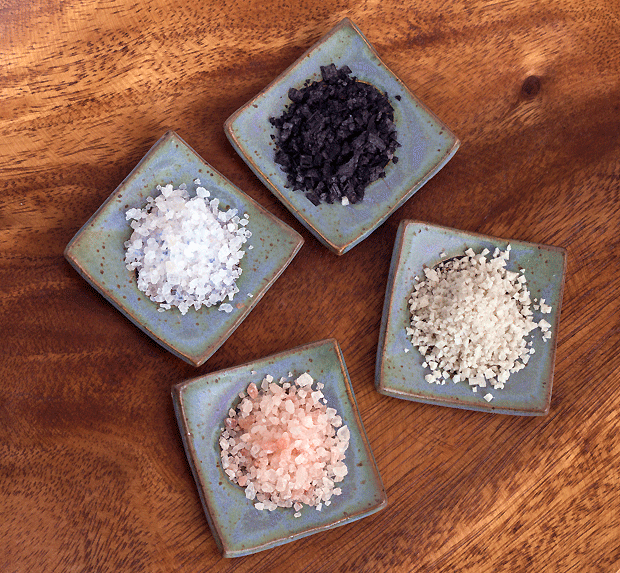How to reduce salt and not feel deprived

When I was a kid there were three kinds of salt in my little world: Rock, kosher and table. That was it. The only specialty salt was Morton’s. Their slogan —When it rains, it pours.— gives you an idea of how simple life was back then. We got excited over salt that wouldn’t clump in humid conditions. Today? Salt comes in more varieties than countries. Colours range from deep, deep red to blushing pale pink, pitch black to soft grey, pure white to cobalt blue. Forget tiny uniform granules that pour effortlessly from a shaker. Salt now comes in blocks you grate, large crystals you grind, or flakes you crumble between your fingers. As the varieties available expand, so does our culinary use. Salt no longer simply flavours our food, it can help cook it. Salt blocks and salt crusts are just two culinary methods were salt isn’t eaten but used as a culinary instrument.
Of course, just as earth’s most common spice gets interesting, health experts warn we need to reduce salt in our diets. Hardly seems fair, does it? The good news is that most of the salt in our diet comes from processed foods. Unless you have a very liberal hand, the salt you add at the stove or at the dining table isn’t the issue. This makes up about 15% of our sodium. Approximately 10% comes from the food itself. And a whopping 75% comes from processing. So, the answer seems simple. When you cook from scratch, you free yourself (or your sodium quota) to explore the joys of salt without guilt.
With the medical evidence piling up against sodium, The Salt Book: Your Guide to Salting Wisely and Well, with Recipes by Fritz Gubler and David Glynn with Dr Russell Keast (Whitecap ©2013) is well-timed.
How much salt do you really need?
Less then we’re consuming, that’s for sure. According to Health Canada, the average Canadian adult needs 1500 mg a day. The average bacon-loving Canuck consumes closer to 3400 mg — more than twice as much as is good for us. This isn’t the kind of over-achievment your mother wanted. (But don’t feel bad, according to The Salt Book, 18th century Europeans consumed a whopping 18 teaspoons (6 tablespoons) of salt a day and that’s without fast foods and prepackaged goods. Of course, they died younger from other causes, but still. You’re not that bad. Are you?)
Creative ways to reduce salt in your diet
Salt brings out flavours, smooths bitterness, intensifies sweets and generally adds depth and life to a dish. You don’t want to eliminate it entirely, but the North American palate is used to a lot of salt, so most of us could do with a bit of readjustment. Your first low-sodium week is usually the most challenging, but within four to six weeks you should have retuned your tastebuds to appreciate food without a lot of salt. (Be warned, once you adjust, many prepackaged and almost all fast foods will taste harshly salty.) To get you started, The Salt Book offers two innovative ways to cut back.
The Sea Breeze:
Simply take an atomizer bottle, add a little salt and then fill it with warm water. Shake to dissolve the salt, and let the water cool. This salted water is a great way to season certain foods, particularly vegetables, with a light, even touch of salt that will not overwhelm them.
Salt and Lemon Parcel:
Simply cut a lemon in half, then sprinkle the cut surface with some coarse sea salt. Take a small square of muslin and wrap that around the lemon, twist the ends and tie with a string. This becomes the perfect vehicle for salting not just seafood but many other dishes. The lemon will dissolve the salt and your food will receive a salty, citrus tang that can be used sparingly, but still to great effect.
Wish I’d known these tricks years back when I was cutting back on salt.
Are you a salt fiend? Have you reduced salt or is it even a concern for you?